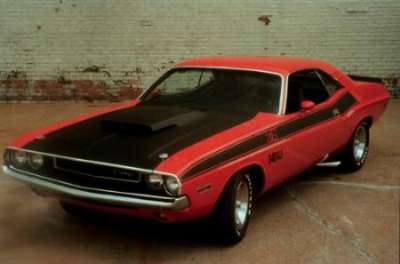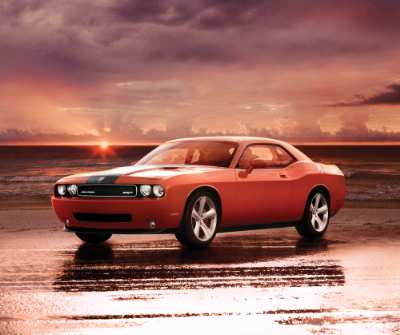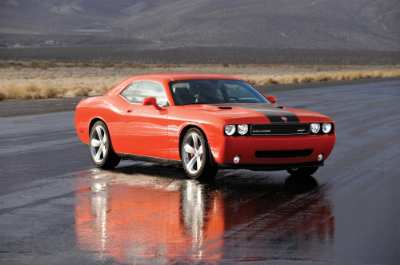|
| ||||||
|
Dodge Challenger SRT8 Revealed In Chicago
7th February, 2008 | |||||
|
The return of America's Dodge Challenger brings what pony car fanatics crave: ground shaking performance, unmistakable design cues reminiscent of the original Challenger, world-class ride and handling characteristics and benchmark braking. On top of that it features a wide variety of modern amenities and technology designed to delight a new generation of driving enthusiasts. “The all-new Dodge Challenger SRT8 is engineered to give customers everything they want in a modern muscle machine,” said Mike Accavitti, Director – Dodge Brand and SRT Global Marketing, Chrysler LLC. “The new version of Dodge’s American classic boasts tyre-smoking performance and head turning design while offering a wide array of state of the art technology, such as GPS navigation, ‘Keyless Go’ entry, a MyGIG™ infotainment system and UConnect hands-free communication.” Developed by Chrysler’s in-house performance engineering organisation, the 2008 Dodge Challenger SRT8 was engineered with a focus on the five pillars of every SRT vehicle: bold exterior design that resonates with the brand image, a race-inspired interior, world class ride and handling across a dynamic range, a stand out powertrain and benchmark braking. Dodge will offer the limited edition 2008 Dodge Challenger SRT8 in three colours: Hemi Orange, Bright Silver Metallic and Brilliant Black Crystal Pearl Coat. Each two-door, rear-wheel-drive coupe will be produced with a numbered dash plaque, carbon fibre like bonnet stripes and will be powered by SRT’s 6.1-litre Hemi V-8 engine that boasts 425 horsepower and 420 lb. ft. of torque. The all new 2008 Dodge Challenger SRT8 arrives in North American Dodge showrooms mid-year. The 2008 Dodge Challenger SRT8 vehicles will be manufactured at Chrysler’s Brampton, Ontario, Canada assembly plant. Performance targets for the all new 2008 Dodge Challenger SRT8 include a 0–60 mph time in the low 5 second range, 0–100–0 mph in less than 17 seconds, a ¼-mile elapsed time of less than 14 seconds, 60–0 mph braking distance of approximately 100 feet and a skid pad performance of 0.88 g. 
Dodge Challenger: History of the Dodge Pony Car Although the Dodge Challenger was the last entrant in the pony car ranks of Detroit’s Big Three, it arrived with something its competitors didn’t have: the greatest range of powertrain choices in the industry, from the small but durable 225-cubic-inch “Slant Six” to the fearsome “Elephant Motor” – the 426 Hemi. And although it lasted only five model years, the Dodge Challenger became one of the most storied muscle car nameplates in automotive history, with meticulously restored and rare examples today selling for six-figure prices. 1970 The Dodge Challenger was originally offered as either a two-door hardtop or convertible, in base, SE (Special Edition), R/T (Road/Track) and T/A (Trans Am) trim. But it was the range of powertrain choices that was truly remarkable:
Driveline choices for various engines included Chrysler’s TorqueFlite automatic transmission and a three or four speed manual which could be equipped with a Hurst “pistol-grip” shifter. Big block Challengers could be ordered with a heavy duty Dana 60 differential equipped with limited slip differential. Even the paint schemes said “performance,” with colours including Plum Crazy and Hemi Orange, accented with “bumblebee” stripes. Customers could further customise their cars with twin-scooped bonnets, “shaker” bonnets and rear wings. Befitting the brand’s performance heritage, the Dodge Challenger went racing in its first year. For the street, it was offered in the limited edition T/A model to meet homologation requirements for Sports Car Club of America (SCCA) Trans Am racing. The T/A was one of the first production vehicles to offer different size tyres, front and back; E60 x 15 in the front, G60 x 15 in the rear. In 1970, Sam Posey drove the lone Trans Am racing Challenger, prepared and run by Ray Caldwell’s Autodynamics Race Shop. While he didn’t win a race in the No. 77 car, Posey finished fourth overall in points. Drag racers including Dick Landy and Ted Spehar also campaigned Challengers in the National Hot Rod Association’s new Pro Stock class. In 1970 and ’71, the Hemi powered Challengers (and Plymouth ‘Cudas) virtually ruled the class. For the 1970 model year, just over 83,000 Dodge Challengers were sold. 1971 As in 1970, a wide range of trim levels, exterior colours and striping options made the Dodge Challenger easy for customers to pick a special car. However, for 1971, Dodge dropped the T/A (it was no longer racing in Trans Am), SE models and R/T convertible. New EPA emission standards led to some powertrain changes; the optional 375-horsepower 440 cubic inch was eliminated, as was the six pack equipped 340 cubic-inch powerplant. The 383 cubic-inch Magnum engine was detuned to 300 horsepower by lowering the compression ratio for improved emissions. However, a 390 horsepower six pack 440 V8 was available and the 425 horsepower 426 cubic inch Hemi still topped the vast engine offerings. A Dodge Challenger paced the Indianapolis 500 race in 1971. Dodge produced 50 Challenger convertible pace car replicas, all painted Hemi Orange with white tops and interiors. 1972 Only three engines were available in the 1972 Dodge Challenger: the 225 cubic inch Slant Six with 110 horsepower, the 318 cubic inch V8 with 150 horsepower and the 340 cubic inch V8 with 240 horsepower. All were equipped to use the then new unleaded fuel. With convertible sales in steady decline over several years, the 1972 Dodge Challenger was offered in hardtop form only. The sun roof had become a more popular alternative and was offered as an option for just over $400 (USD). New front end styling in 1972 featured a larger, “egg-crate” grille. It was painted argent for standard Challengers and black on the Challenger Rallye performance model, which replaced the R/T. The Challenger’s tail lamp design included twin lights on each side, with the centre panel painted the same colour as the grille. The Rallye model was also equipped with four small scoops on the front guards. 1973 Inside, grained vinyl was the only available seating material, but a new instrument cluster design was part of the Rallye option package. The Rallye was eliminated as a separate model, although customers could make one with options. Under the bonnet, the six-cylinder engine was no longer available; the 150 horsepower 318 cubic inch V8 was standard, with the 240 horsepower 340 cubic inch V8 as the only option. 1974 Inside, the lap and shoulder belts were equipped with an inertia reel. In addition, there was a federally mandated seatbelt ignition interlock, which prevented the car from being started if the driver or passenger didn’t buckle up. The Dodge Challenger offered a different engine option for 1974. With the 318 cubic inch V8 still standard, a 360 cubic inch V-8 producing 245 horsepower replaced the 340 V8 as the only option. In April 1974, Challenger production ceased. Over a five-year span, approximately 188,600 Dodge Challengers were sold. 1978-1984 Slightly restyled in 1981, the Dodge Challenger soldiered on until 1984, replaced by the growing stable of Chrysler corporation’s front wheel drive 'K-platform' compacts and a new import from Mitsubishi, the Dodge/Plymouth Conquest (known as Mitsubishi Starion in some markets). Over its six year run, sales of the Mitsubishi built Dodge Challenger pillarless coupe averaged between 12,000 and 14,000 units per year. 
2006 Over the next several months, the company received repeated pleas from consumers and the media to build the car. There are no known plans to manufacture the new Dodge Challenger with right hand drive and there are no known plans to export the North American car. | ||||||
ABN 47106248033 |
 |
All rights reserved. |


